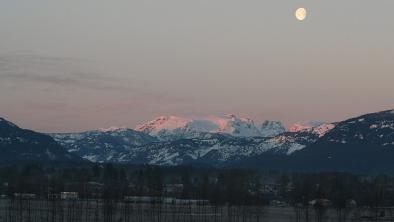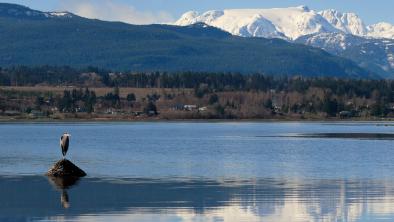Coal mine prompts environmental concerns
Vancouver Sun
Comox Valley would be transformed into a grimy, industrial 'mini-Appalachia,' warns University of Victoria Environmental Law Centre
A coal mine proposal, which some fear could be the first step in transforming Vancouver Island's Comox Valley into a grimy, industrial "mini-Appalachia," threatens some of British Columbia's most productive and successful shellfish aquaculture and requires a full federal-provincial environmental assessment, says the University of Victoria's Environmental Law Centre.
The Raven mine proposed for Buckley Bay would be the first phase of an ambitious development that could later expand to exploit an estimated 100 million tonnes of coal on the Island's eastern slope.
But the Environmental Law Centre warns that in addition to oyster farms, the mine could also put at risk public health, municipal drinking water, regional air quality and the habitat of at least seven blue-listed species.
Furthermore, it argues, the proposal has now created such widespread anxiety in Comox Valley communities which trade upon the natural beauty of their region that full public participation in any independent environmental assessment is essential.
So far, Compliance Coal Corporation's proposed Raven mine is subject to an internal environmental assessment by provincial bureaucrats, the Environmental Law Centre says.
"This internal government process cannot be adequate to assess the issues raised by the proposed mine," it says in a 25-page letter to both federal and provincial governments obtained by The Vancouver Sun.
The Environmental Law Centre provides research and legal advocacy on environmental issues it deems in the public interest.
Located near Buckley Bay, south of Comox, the Raven underground mine would extract high quality metallurgical coal used in steel industry blast furnaces.
Its full extent below ground would cover roughly the same area as 5,000 football fields and would involve the watersheds of three creeks and a river draining into Baynes Sound between Denman Island and Vancouver Island about 70 kilometres northwest of Nanaimo.
There's a long history of coal mining in the region. Since the late 19th century, Cumberland, Nanaimo, Wellington and Ladysmith have had more than a dozen underground operations -- and some of the worst mining disasters in Canadian history.
One surface mine is now active near Campbell River.
However, the total development now envisaged could stretch from Buckley Bay to Campbell River.
It could later involve strip mining of deposits to extract lower grade coal for burning in thermal electrical generation plants.
In a letter to federal and provincial environment ministers Jim Prentice and Barry Penner, and to Andrew Rollo of the Canadian Environmental Assessment Agency, with copies to federal Fisheries Minister Gail Shea and federal Transport Minister Chuck Strahl, the Environmental Law Centre warns that the process for assessing the present proposal's environmental impact is inadequate considering the magnitude of risk.
It requests that Prentice refer an environmental assessment of the Raven mine proposal to a joint federal-provincial review panel of independent experts with full public hearings.
And it asks Penner to ensure the environmental assessment is carried out by the same panel conducting those public hearings.
"The proposed coal mine has profound implications for the environment and future of mid-Vancouver Island, and therefore requires this most thorough form of public participation and review," the letter says.
It cites a recent administrative fiasco at a proposed gold and copper mine project near Williams Lake in which the province relied upon an internal review by civil servants without holding full public hearings.
The province concluded any adverse environmental impacts from the mine could be mitigated, only to later be embarrassed by an independent federal review panel which determined the project would not only have serious adverse environmental impacts but that they could not be mitigated by the proposed measures.
The Environmental Law Centre says that federal panel noted serious deficiencies in the B.C. government's internal approach, in particular that the province had ignored federal agency reports warning about effects on water quality, fish, migratory birds and human health. It also observed that the province had ignored "extremely valuable" evidence from first nations.
In the case of the Buckley Bay mine proposal, "full public hearings conducted by independent experts are necessary to reassure the people of Vancouver Island that similar deficiencies will not arise in the assessment of the current project proposal," the Environmental Law Centre says.
Among the most serious concerns the letter mentions is a potential for acid mine drainage from exposed and waste rock during the mining process. Toxic effluent leached from rocks can include arsenic, cadmium, chromium, copper, lead, mercury, selenium and zinc.
The letter details other examples of acid mine drainage and the environmental consequences for B.C. taxpayers.
Britannia mine near Squamish later required a $30-million water treatment centre to deal with pollution from the former underground copper mine which adversely affected millions of migrating juvenile salmon, it says, while Equity Silver mine near Houston required cleanup facilities that may have to be maintained for centuries after seriously damaging adjacent fisheries.
An open pit copper mine on Mount Washington near Courtenay operated for only four years but "utterly devastated" a multimillion-dollar fishery in the Tsolum River that included stocks of rainbow, steelhead and cutthroat trout, coho, pink and chum salmon. It required an outlay of $4.5 million in public money in attempting to mitigate the consequences.
Recent studies have found high levels of arsenic and sulphates in lakes surrounding the only operating coal mine on Vancouver Island, the Environmental Law Centre says.
In some places, the letter says, arsenic levels around the Quinsam Coal Mine near Campbell River are as much as 30 times above provincial water quality guidelines.
"Of particular concern for the local shellfish industry, the study also found that freshwater mussels placed in the lake accumulated arsenic in their tissues. Residents are concerned that the kind of contamination at Quinsam could happen with the Raven Underground Coal Project, which is located very near Baynes Sound's large commercial shellfish beds."
Baynes Sound is the site of extensive commercial oyster-growing operations worth $9 million a year and employing 600 people.
"The B.C. Shellfish Growers Association has expressed extreme concern about the potential environmental impacts of the proposed mine," the letter says.
Shellfish operators want immediate comprehensive studies of the aquatic impact of any toxic run-off including the cost of lost shellfish production in the area, says the UVic body.
Other concerns expressed in the letter include:
-Risks to public health based on studies which show residential proximity to coal mines is associated with poorer health and with higher risks of cardiopulmonary and chronic lung disease, hypertension and kidney disease;
-Research which shows abandoned coal mines flood and increase dissolved minerals in groundwater, and UVic research which found disease and ill health more common in the former coal mining community of South Wellington, where residents draw drinking water from wells showing high levels of aluminum, antimony, cadmium, iron, lead, selenium, sodium and thallium;
-Economic impacts on tourism and ecotourism in the popular Comox Valley;
-Impacts on real-estate values in a region which pitches itself as a retirement destination, and on associated businesses which service a growing retirement population;
-Increased road hazards on inadequate highway infrastructure as coal would be transported 80 kilometres to the nearest deep sea loading facilities at Port Alberni, requiring 52,416 trips by 42-tonne capacity trucks
-Coal storage and associated issues of light and noise pollution, danger of coal dust explosions, spontaneous combustion in coal piles, degraded air quality from coal dust and negative impacts on surrounding residents from visual esthetics;
-Impacts on hydrology including contamination of aquifers, watersheds and the ocean as well as the impacts on local water supplies caused by extraction of large volumes of fresh water for use in the mining process -the letter cites elevated levels of selenium in water associated with coal mines in southeastern B.C. and northwestern Alberta;
-Climate change implications -it's projected the mined coal could produce almost the same amount of carbon dioxide that the provincial gasoline carbon tax imposed on British Columbians is projected to remove from the atmosphere.
The letter says worry about these issues has generated widespread public anxiety throughout the region. It says five municipalities also want a full federal environmental assessment.
Residents of Denman Island on Baynes Sound and the Islands Trust Council have expressed concern.
"Citizens are concerned that the Comox Valley will be transformed into a Coal Valley where their health and environment will be compromised, their roads rendered unsafe and the local shellfish industry devastated," the Environmental Law Centre's letter says.
"Residents are concerned that approval of the mine could permanently change the use and enjoyment of a substantial part of Vancouver Island."
It seems to me that on the basis of such concerns the Environmental Law Centre makes a reasonable case.
Whether you are in favour of coal mine development or against it, the public interest demands that a project of such scope and potential impact be subjected to the full and objective scrutiny of an independent arm's length environmental assessment.
If there's no problem, people deserve to be reassured.
If there is a problem, people deserve to know.
Premier Gordon Campbell and the Liberals came to power in 2001 promising the most open and transparent government we'd ever had, so what could be the objection to a full vetting of this proposed project by arm's-length experts with public hearings to let those who will be most affected have their say in the shaping of policy?

